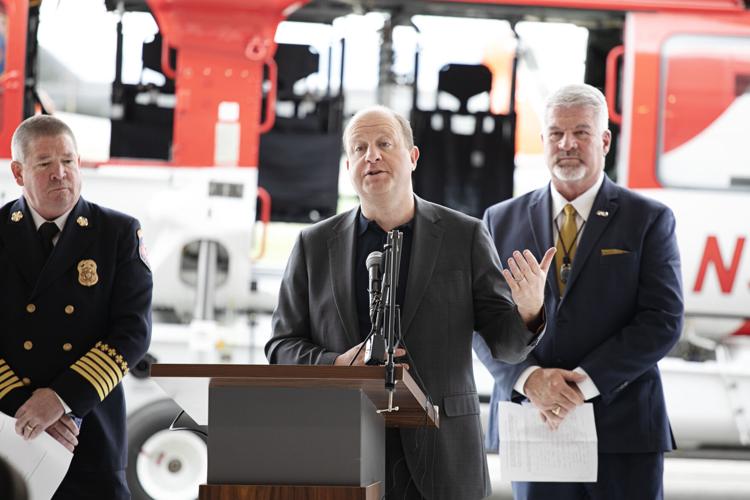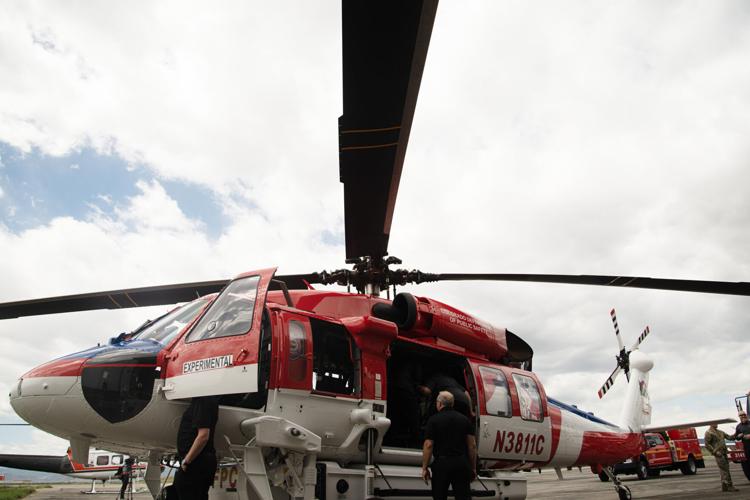Colorado can expect a normal wildfire season this year, very similar to last, as the state flexes enhanced firefighting practices in the wake of devastating fires. The Colorado Division of Fire Prevention and Control (DFPC) outlined the state wildfire preparedness plan to Gov. Jared Polis during a press conference at Rocky Mountain Metropolitan Airport Wednesday.
The event in Broomfield — which houses a base for U.S. Forest Service air tankers — drew Polis, DFPC Executive Director Mike Morgan, Colorado Department of Public Safety Executive Director Stan Hilkey and Colorado State Forest Service Director Matt McCombs.
Behind the speakers stood the newest addition to Colorado’s air tanker fleet, a brand-new S-70 Firehawk.
Based on the military Blackhawk helicopter, the Firehawk is classified as a type I helicopter air tanker, meaning it is the largest and fastest type of firefighting helicopter. The Firehawk can carry 1,000 gallons of water or fire retardant, according to manufacturer Lockheed Martin.
The helicopter has been the subject of a fiscal fiasco after its purchase. The state of Colorado paid $2.3 million last year for pilots and mechanics for the helicopter, even as it sat in a hanger unused. After purchasing it for $24 million in 2021, the Firehawk generated so much excitement in the legislature, lawmakers earmarked an additional $26 million for a second, according to The Denver Gazette's media partner 9NEWS.
The first is operational — arguably stealing the limelight as the star of the morning press conference — while the second is expected to be delivered in 2025. The state included $7.3 million for aviation resources in the 2024 budget, as well as $4.1 million for the wildfire preparedness fund.
In addition to the new Firehawk, Colorado operates a fleet of smaller helicopters, large air tankers, single-engine air tankers and a pair of multirole aircraft.
Though not the only aspect of wildland firefighting, aircraft are a highly visible part of the response. The state’s outlook for wildfire’s this year is “normal,” with the southeastern part of Colorado seeing the potential for elevated risk early in the summer.
“The 2024 Wildfire Preparedness Plan outlines a holistic, comprehensive approach to wildfire management that includes suppression and response, fuels and forest management, and mitigation activities of all types,” Morgan said. “Together with our local and federal partners, the State of Colorado stands ready to respond to wildfires.”
State leaders implored residents to be responsible and smart when out in the wilderness regardless, saying 90% of wildland fires are started by humans. Indeed, three of the largest and most destructive wildfires in state history — the Marshall fire, Cameron Peak fire and the Black Forest fire — were all likely human caused.
But this year's normal outlook is tempered by the presence of "bugs and crud," according to McCombs. These pests don't know boundaries, necessitating quick responses from the state forest service and federal partners in the event of a wildfire.
"Despite wetter and cooler years the last couple years we saw bark beetles and other pests actually expand their footprint across Colorado's forests," McCombs said. "We recently established a monitoring program at the state Colorado State Forest Service that will allow us to assess the effectiveness of our response to these ever-present bugs and crud that continue to impact our stressed forests."
Through partnerships with federal agencies like the Bureau of Land Management and the U.S. Department of Agriculture Forest Service, Colorado is leading the country and the west in flexible response as part of the Forest Service's Good Neighbor Authority, he said.
Polis emphasized that as the climate becomes hotter and drier, the state needs to be more proactive in its approach to wildfire response. This can be done with more robust mitigation efforts, intelligence gathering, rapid response and finding new ways to enhance statewide capabilities, Polis said.
“Colorado is no stranger to the impact of devastating wildfires, and we refuse to rest when it comes to preparing for the future," he said. "Colorado is a national leader in fire mitigation efforts, and we continue building on proven methods to protect Coloradans and our communities from wildfires.”












(4) comments
The 53 flies MUCH farther
Motion is what democrats call action. rinse and repeat.
Blackhawk: 8000 pound max load (1000 gallons of water)
CH-53E: 36,000 pounds. (over 4000 gallons of water).
We left half billion dollars worth of Blackhawks in Iran.
This is ridiculous. At least use a CH-53E
Welcome to the discussion.
Log In
Keep it Clean. Please avoid obscene, vulgar, lewd, racist or sexually-oriented language.
PLEASE TURN OFF YOUR CAPS LOCK.
Don't Threaten. Threats of harming another person will not be tolerated.
Be Truthful. Don't knowingly lie about anyone or anything.
Be Nice. No racism, sexism or any sort of -ism that is degrading to another person.
Be Proactive. Use the 'Report' link on each comment to let us know of abusive posts.
Share with Us. We'd love to hear eyewitness accounts, the history behind an article.